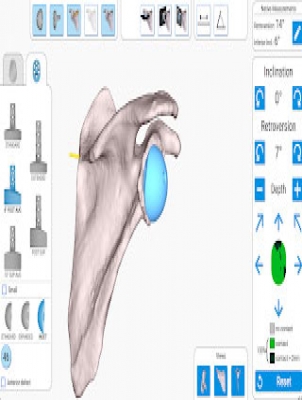The most challenging step of shoulder replacement for surgeons is the preparation of the glenoid. The Glenoid is the "socket" of the shoulder. Due to years of degeneration and bone wear, the glenoid can become deformed. This presents a challenge when trying to implant a new socket for a traditional shoulder replacement or a baseplate for a reverse shoulder replacement.
Various companies have come up with ways of planning the surgery on a "virtual" computer program. This is helpful for surgeons, who traditionally rely on visual landmarks at the time of surgery. Because of soft tissues, bleeding, or tight musculature, it can be hard to be certain that the surgery is following the plan. Studies have shown improved accuracy when surgeons use custom made guides for this step.
Here's a recent case I performed. The patient had significant bone loss to the socket. Prior to surgery, we obtain a CT scan of the shoulder. Using this scan, we are able to place the implants in a "virtual" environment. Using this technology, I am able to determine the proper depth, version, and inclination of the reaming and implant placement.

An example of the preop planning software appearance.
On the day of surgery, we are able to recreate the plan more accurately since the GPS guides the orientation of our instruments. There is an array of cameras that receive signals from "trackers" we place on the patient and on our instruments. Surgeons can use this real-time data to make adjustments to optimize the position of the glenoid component.

The GPS can see the "trackers" (red circles) and give real-time feedback about orientation.
My opinion of this technology is that it is not always necessary, but it can be helpful in challenging cases. The biggest difference it makes for me is the ability to place longer screws when implanting a reverse total shoulder replacement since the computer shows me the screw trajectory in the bone. Such long screws may help with getting more solid fixation compared to a shorter screw.
Here is the postoperative X-ray, showing the placement of the implant. Note the long screw (arrow).



